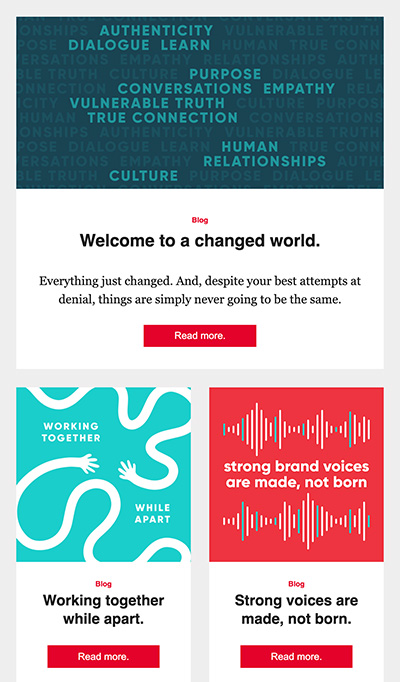Rebranding: internal v. external.
Fulfilling a re-energized brand promise requires both internal and external engagement.

In the dozens upon dozens of major rebranding engagements and efforts we’ve been involved with, one thing has become exceedingly clear: rebranding an organization is equally important within the walls as it is to the outside world.
There is nothing quite like cutting through the clutter and showing a company what it looks, sounds, and acts like at its finest. It gets people re-energized. It gets them on the same page. It makes them want to become the company they see in front of them. It is motivational. It builds aspiration. And, more than anything, it gets people excited to go to work again.
In order to see why organizations crave a strong brand internally, let us quickly break down the lifecycle of an organization that leads down the path to status quo. This is the case of several companies we’ve worked with.
- The company is formed with an entrepreneurial spirit and a clear vision and passion, generally created by one individual.
- The company grows, and this individual shares his contagious spirit and wills the company to success.
- The owner sells to a larger organization, leaves the organization, stops day-to-day activity, etc.
- The company is left with a series of systems but no real soul or driving force. The brand reflects a “good enough” mentality but does not reflect any passion or sense of exceptionality.
- This goes on for some time. The brand becomes more and more internally focused on “what we do” vs. “why we exist for our customers”. Major difference.
- The company gets more and more layered, with more services/products, new departments, new technologies, etc. There are acquisitions, partnerships, business changes. All adding new personalities, layers, and needs.
- The business goes on cruise control on every level. Mission, vision, and values are created, but they are generally clichéd and empty. The outside world starts to lose touch.
- The brand starts to reflect a certain “say nothing” mentality. The internal staff, while still committed and passionate about their individual positions, has an increasingly difficult time when asked “what does your company do?”
- Internally, correction is attempted. Through meetings, retreats, and other common methods, a “reason for being” is attempted to be recaptured. Unfortunately, it is through people who are too close to it, have seen too many of these steps, and who have a vested interest in their own “piece” of the puzzle rather than the big picture.
That is why companies like ours exist. We are able to get to the deep issues, connect dots, and see the company from a 30,000 foot perspective. We can then start to rebuild the energy and thought that went into #1, no matter how big or diffused the company has become.
This is done in order to communicate to the outside world. But every single time, our effect within the walls of the organization is just as great. This, in turn, leads to an organization that lives up to its new, re-energized brand promise.


